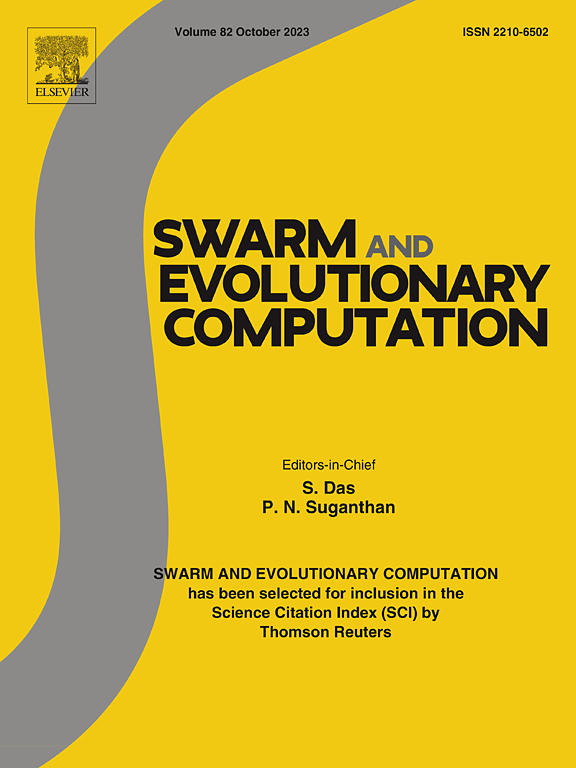基于趋势分析的动态多目标进化优化预测策略
IF 8.5
1区 计算机科学
Q1 COMPUTER SCIENCE, ARTIFICIAL INTELLIGENCE
引用次数: 0
摘要
动态多目标优化问题(dops)随着时间的变化而变化,这需要进化算法(EA)在动态环境中跟踪帕累托最优解(PS)和/或帕累托最优前沿(PF)。大多数基于预测的算法仅使用单个模型来学习解决方案预测的变化模式。面对复杂的dmp,它们可能会取得令人不满意的性能。为了解决这一问题,本文提出了一种新的基于趋势分析的预测策略。基于以往的人口信息,设计了一个简单的趋势分析来提取每个解决方案的变化模式,并将其分为不规则、平移和平稳三类。对于不规则变化解,提出了一种神经网络非线性模型来预测新的位置。对于平移变化解,建立了一个简单的线性模型来估计它们的新位置。对于固定溶液,它们是保留的。因此,TAP对不同的动态环境更敏感。将TAP算法与基于分解的动态多目标进化算法(MOEA/D)相结合,构造了一种新的算法MOEA/D-TAP。为了验证该方法的性能,在4种不同基准的26个测试实例上与6种最先进的方法进行了对比实验。测试结果表明,TAP具有很强的竞争力。本文章由计算机程序翻译,如有差异,请以英文原文为准。
Trend analysis-based prediction strategies for dynamic multi-objective evolutionary optimization
Dynamic multiobjective optimization problems (DMOPs) change over time, which require Evolutionary algorithms (EA) to track Pareto-optimal solutions (PS) and/or Pareto-optimal front (PF) in a dynamic environment. Most prediction-based algorithms solely use a single model to learn the changing pattern for solution prediction. In the face of complex DMOPs, they may achieve an unsatisfactory performance. To address this issue, a novel trend analysis-based prediction strategy (TAP) is proposed in this paper. Based on previous population information, a simple trend analysis is designed to extract the changing pattern of each solution, and classify them into different types: irregular, translational, and stationary. For irregular changing solutions, a neural network nonlinear model is presented to predict the new location. For translational changing solutions, a simple linear model is built to estimate their new positions. For stationary solutions, they are preserved. As a result, TAP is more responsive to different dynamic environments. TAP is incorporated into the dynamic multiobjective evolutionary algorithm (DMOEA) based on decomposition (MOEA/D) to construct a novel algorithm denoted as MOEA/D-TAP. To verify the performance of the proposed method, comparison experiments are carried out on 26 test instances of four different benchmarks compared with six state-of-the-art methods. The test results indicate that TAP is highly competitive.
求助全文
通过发布文献求助,成功后即可免费获取论文全文。
去求助
来源期刊

Swarm and Evolutionary Computation
COMPUTER SCIENCE, ARTIFICIAL INTELLIGENCEC-COMPUTER SCIENCE, THEORY & METHODS
CiteScore
16.00
自引率
12.00%
发文量
169
期刊介绍:
Swarm and Evolutionary Computation is a pioneering peer-reviewed journal focused on the latest research and advancements in nature-inspired intelligent computation using swarm and evolutionary algorithms. It covers theoretical, experimental, and practical aspects of these paradigms and their hybrids, promoting interdisciplinary research. The journal prioritizes the publication of high-quality, original articles that push the boundaries of evolutionary computation and swarm intelligence. Additionally, it welcomes survey papers on current topics and novel applications. Topics of interest include but are not limited to: Genetic Algorithms, and Genetic Programming, Evolution Strategies, and Evolutionary Programming, Differential Evolution, Artificial Immune Systems, Particle Swarms, Ant Colony, Bacterial Foraging, Artificial Bees, Fireflies Algorithm, Harmony Search, Artificial Life, Digital Organisms, Estimation of Distribution Algorithms, Stochastic Diffusion Search, Quantum Computing, Nano Computing, Membrane Computing, Human-centric Computing, Hybridization of Algorithms, Memetic Computing, Autonomic Computing, Self-organizing systems, Combinatorial, Discrete, Binary, Constrained, Multi-objective, Multi-modal, Dynamic, and Large-scale Optimization.
 求助内容:
求助内容: 应助结果提醒方式:
应助结果提醒方式:


